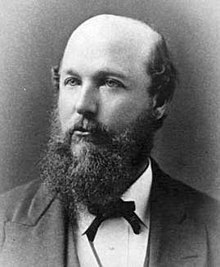| Irving Stringham | |
|---|---|
 | |
| Born | (1847-12-10)December 10, 1847 Yorkshire, New York, U.S. |
| Died | October 5, 1909(1909-10-05) (aged 61) Berkeley, California, U.S. |
| Nationality | American |
| Alma mater | Harvard College Johns Hopkins University |
| Scientific career | |
| Fields | Mathematics |
| Institutions | University of California at Berkeley |
| Doctoral advisor | James Joseph Sylvester |
Washington Irving Stringham (December 10, 1847 – October 5, 1909) was an American mathematician born in Yorkshire, New York. He was the first person to denote the natural logarithm as where is its argument. The use of in place of is commonplace in digital calculators today.
"In place of we shall henceforth use the shorter symbol , made up of the initial letters of logarithm and of natural or Napierian."
Stringham graduated from Harvard College in 1877. He earned his PhD from Johns Hopkins University in 1880. His dissertation was titled Regular Figures in N-dimensional Space under his advisor James Joseph Sylvester.
In 1881 he was in Schwartzbach, Saxony, when he submitted an article on finite groups found in the quaternion algebra.
Stringham began his professorship in mathematics at Berkeley in 1882. In 1893 in Chicago, his paper Formulary for an Introduction to Elliptic Functions was read at the International Mathematical Congress held in connection with the World's Columbian Exposition. In 1900 he was an Invited Speaker at the ICM in Paris.
Personal life
Irving married Martha Sherman Day. The couple raised a daughter, Martha Sherman Stringham, (March 5, 1891- August 7, 1967).
References
- Charles Smith, Irving Stringham, Elementary algebra for the use of schools and colleges 2nd ed, (The Macmillan Company, New York, 1904) p 437.
- W.I. Stringham "Regular Figures in N-dimensional Space", American Journal of Mathematics Vol 3 (1880) pp 1-15.
- I. Stringham (1881) "Determination of the finite quaternion groups", American Journal of Mathematics 4(1–4):345–57 doi:10.2307/2369172
- "In Memoriam, Dean Stringham" University of California Chronicle Vol XII (University Press, Berkeley, 1909) pp 1–20.
- "Formulary for an Introduction to Elliptic Functions by Irving Stringham". Mathematical papers read at the International Mathematical Congress held in connection with the World's Columbian Exposition. NY: Macmillan as publisher for the AMS. 1896. pp. 350–366.
- "Orthogonal transformations in elliptic, or in hyperbolic, space by Irving Stringham". Compte rendu du deuxième Congrès international des mathématiciens tenu à Paris du 6 au 12 Aout 1900. Vol. Tome 2. 1902. pp. 327–338.
Publications
- I. Stringham (1879) The Quaternion Formulae for Quantification of Curves, Surfaces, and Solids, and for Barycenters, American Journal of Mathematics 2:205–7.
- I. Stringham (1901) On the geometry of planes in a parabolic space of four dimensions, Transactions of the American Mathematical Society 2:183–214.
- I. Stringham (1905) "A geometric construction for quaternion products", Bulletin of the American Mathematical Society 11(8):437–9.
External links
- Irving Stringham at the Mathematics Genealogy Project
- Portrait of W. Irving Stringham from Mathematics Department University of California, Berkeley
- San Francisco Call 6 October 1909 re Irving Stringham death, from California Digital Newspaper Collection.
 where
where  is its argument. The use of
is its argument. The use of  is commonplace in
is commonplace in  we shall henceforth use the shorter symbol
we shall henceforth use the shorter symbol  , made up of the initial letters of logarithm and of natural or Napierian."
, made up of the initial letters of logarithm and of natural or Napierian."